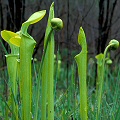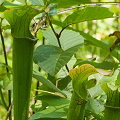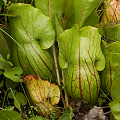Q: What are ICPS "Location Codes"?

Sarracenia oreophila

Sarracenia jonesii

Sarracenia purpurea
var. montana
A: It is ICPS policy not to publish the locations of rare plants to
any degree of accuracy finer than county level (or its equivalent). However, in 2003
the ICPS implemented a short term program to distribute rare plants that
are covered by the US Endangered Species Act; this first-attempt at the program
was limited to specimens of
Sarracenia alabamensis subsp. alabamensis. Since die-hard Sarracenia growers often like
to know the location information (i.e. provenance data) for their plants,
there was a conflict in how to deal with the release of location information.
To resolve this, the ICPS distributed plants with
"Location Codes" on them. These codes are AL001, AL002, and AL003,
and indicate three sites in Alabama.
The ICPS has Location Codes for many more sites than just those
three sites---it has Location Codes for sites in the USA states
of Alabama, Georgia, South Carolina, and North Carolina. These will be
described in ICPS publications and programs if and when the ICPS obtains
seeds or plants it could distribute via its conservation program.
The ICPS will, under no conditions, reveal the identity of these locations.
However, growers who obtain plants from these locations via the ICPS will know
that they have plants from separate locations.
By not revealing the identity of these locations to the public, the ICPS's
conservation partners will, it is hoped, be more willing to provide seeds to the ICPS
for future conservation programs. Indeed, if this program is
considered successful, the ICPS may expand it to include other rare taxa.
It depends upon whether or not horticulturists do their part and
start distributing seeds of this plant among each other and to carnivorous
plant seed banks.
Why did the ICPS do this? Because this way these rare plants will be more
easily obtained by horticulturists in a legal way. Horticulturists benefit
because they will get plants from different sites via a reliable source (the
ICPS). The plants benefit because there will be less need for irresponsible
people to illegally field collect them. The ICPS benefits because this project
fits perfectly into its mission of encouraging "Horticulture, conservation,
and science of carnivorous plants." The ICPS, by the way, priced plants
in its distribution program very inexpensively, i.e. just to cover costs.
For more information about the rare plants in this program, look at the following
FAQ pages:
Sarracenia alabamensis in detail
Sarracenia jonesii in detail
Sarracenia oreophila in detail
What are ICPS Location Codes and how do
they relate to conservation?
ICPS web site
(to learn about its conservation program)
For more about Location Code sites
AL001, AL002, AL003, go to the next FAQ entry!
By the way, Location Codes should not be misinterpreted as cultivar
designations,
so if you obtain a plant with an ICPS location code, do not denote it with
singe quotes, like the following:
WRONG.... Sarracenia alabamensis 'AL003' ....WRONG
Instead, I would advise you indicate provenance information in the same format
that the ICPS seed bank uses, i.e.
Sarracenia alabamensis---AL003
Page citations: Rice, B.A. 1996, 2001a; Rice, B.A. 2003a; personal observation.